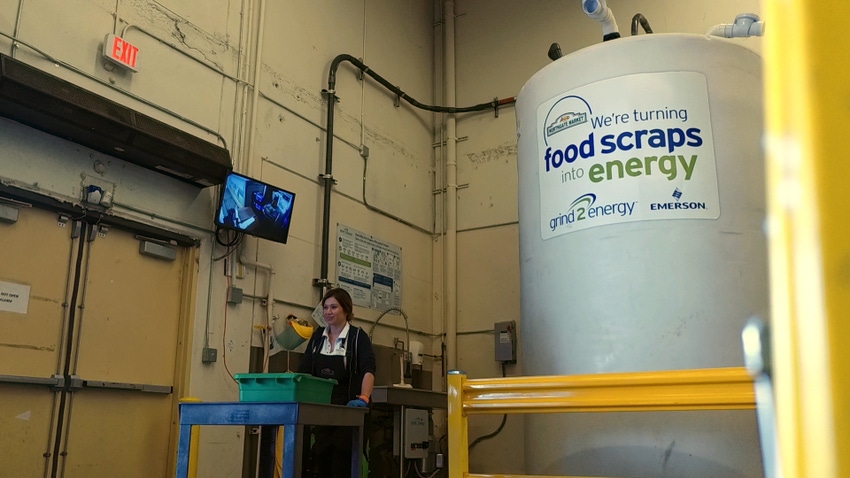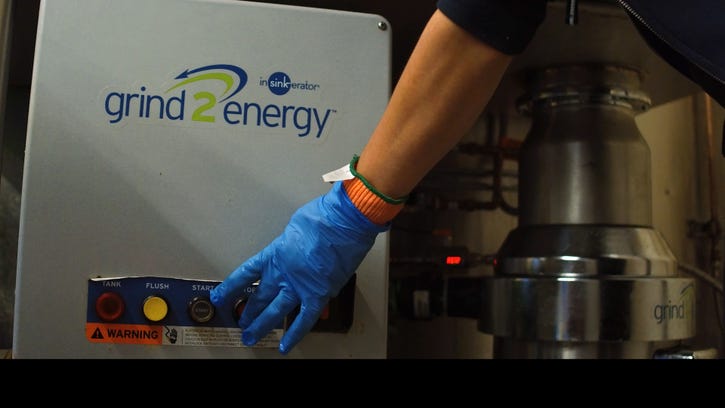AT&T integrated IoT connectivity and robust reporting into Emerson’s Grind2Energy food waste recycling system to increase output.

Around the globe, approximately one-third of all food produced for human consumption is lost or wasted, according to the U.S. Environmental Protection Agency (EPA). And in an effort to reduce that number and to put food waste to better use, Emerson and AT&T have joined forces.
Over the past year, the duo has worked together to divert about 7,400 tons of food waste from landfills, all thanks to technology and the Internet of Things (IoT). Combining Emerson’s Grind2Energy food waste recycling system, an industrial food grinder that turns food scraps from commercial kitchens into a nutrient-rich slurry, and AT&T’s IoT connectivity and robust reporting, the companies have been able to increase the system’s output and turn the food waste into clean energy and fertilizer with the help of anaerobic digestion partners.
“As a company, one of our goals was to try and do a lot of things for our customers in remote places that had to be done manually, and when the opportunity arose to minimize those manual tasks by remotely monitoring our systems, collecting data from the systems and sharing that data with our customers via an online portal, we knew we had to at least try it,” says David Krems, general manager of the commercial solutions group at Emerson.
The partnership between Emerson and AT&T goes back a long way, according to Krems, and when Emerson began accepting proposals for ways to enhance its Grind2Energy system, the proposal that AT&T submitted just so happened to be exactly what Emerson was looking for.
“When I heard about the opportunity to work with Emerson on a solution to make its system scale up, I was excited and knew that we could help make it work more efficiently,” says John Schulz, director of sustainability integration for AT&T. “This partnership goes hand-in-hand with our public goal of reducing our own footprint and helping our customers reduce their carbon emissions. Managing food waste is an obvious way to reduce carbon emissions, and Emerson’s hardware and expertise combined with AT&T’s technology integration expertise really equals the path to reach our set goals.”

To begin integrating IoT and reporting into Grind2Energy, the companies first discussed the business problem of not being able to handle manual tasks remotely, and then built in effective and efficient features to scale the system in three main ways. The first is improving customer service levels. Via the new features, a customer can call Emerson’s customer service line, and a representative can see the customer’s system to troubleshoot the problem remotely opposed to sending a tech onsite to fix the issue.
The second is minimizing cost and maximizing the return on investment for customers, which is done through sensors that are in the system’s tank. The sensors measure the levels in the tank and predict when it will fill up, so customers know precisely when to pump the tank.
The third is the online dashboard, which serves as a customer portal where customers can view and pull data, see the run times they are using, download sustainability reports so they can see the impact they are making and more.

“The new features and equipment added to the system really provide a clear picture of the data in a way that makes sense,” says Schulz. “Emerson ended up using 16 sensors that collect data through the IoT connectivity that AT&T provides, and we helped them identify the touch points for those sensors and the type of data that needed to be collected, like the water flow rate.”
“For the online dashboard, we used the AT&T Control Center, which is our IoT platform that we developed, to pull all the information together and show key metrics of the performance of the equipment,” he adds. “In this platform, there are about 60 analytical cognizations that are available to customers, so both Emerson and its customers can collect and view the data they want, identify and troubleshoot problems and identify milestones and goals.”
To date, the companies have helped divert about 7,400 tons of food waste from landfill, which is slated to produce an estimated 1.3 million kilowatt hours of clean electricity and 420 tons of fertilizer in 2018. And going forward, they are enhancing their business models and strategies to increase that number.
Emerson has been going at the market through a direct sales channel that is now evolving in two areas: working more with foodservice sales reps that utilize other Emerson technologies and partnering with waste haulers that see the value in providing technologies and solutions to the customers they are already servicing.
“While most food waste can be avoided, there are some unavoidable items that businesses and residents have to discard,” explains Krems. “With Grind2Energy, customers don’t feel as guilty about tossing those unavoidable items because, in this case, the food waste is no longer really waste because it’s being turned into electricity and fertilizer. Our customers really understand that they are doing something good with the material opposed to sending it to landfill, so it’s exciting to see more of our existing customers and hauler partners getting on board with this solution.”
Since this partnership has been a success thus far, AT&T and Emerson are looking to take their partnership a step further. Supporting AT&T’s public waste reduction goal, Emerson is now conducting waste audits at some of AT&T’s buildings where Grind2Energy potentially could be installed.
“We have a goal of reaching zero waste at 100 of our buildings in the next two years or so, and to get to that end goal, expanding this partnership and incorporating Emerson’s solution into more of our operations just makes a lot of sense,” states Schulz.
About the Author(s)
You May Also Like




